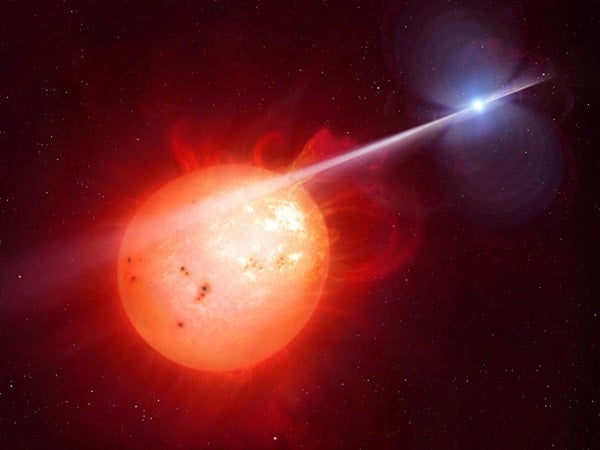There exist hundreds of binary star systems, but none as exotic as the one in AR Scorpii.
Astronomers using European Southern Observatory’s (ESO) Very Large Array (VLA), with other telescopes around the globe, have detected a new type of binary star in the system. A rapidly spinning white dwarf star enables electrons to accelerate to near the speed of light, which then unleashes bursts of this energy upon its companion red dwarf star. The entire system pulses dramatically every 1.97 minutes with radiation ranging from radio to ultraviolet. This study was published July 28 in Nature.
AR Scorpii lies in the constellation Scorpius about 380 light-years from Earth. The white dwarf is approximately the size of the Earth but contains nearly 200,000 times more mass than our planet, while the red dwarf is only one-third the mass of the Sun; they orbit each other every 3.6 hours.
As the white dwarf spins very rapidly, its incredibly strong magnetic field accelerates electrons nearly to the speed of light. As the electrons whip through space, they emit radiation in a beam similar to that of a lighthouse which lashes across the red dwarf every 1.97 minutes. This causes the entire system to seemingly pulse every two minutes. These pulses are so powerful, radio signals are emitted, which has never before been detected in a white dwarf system.
Tom Marsh, lead researcher of the study from the University of Warwick’s Astrophysics Group said in a press release: “AR Scorpii was discovered over 40 years ago, but its true nature was not suspected until we started observing it in 2015. We realized we were seeing something extraordinary within minutes of starting the observations.”
The radiation across a wide band of radio frequencies is indicative of accelerated electrons in magnetic fields, which is found by AR Scorpii’s spinning white dwarf. The mysterious aspect of this study is the source of the electrons. It is not clear whether they are associated with the white dwarf or the cooler red dwarf.
AR Scorpii was first seen in the 1970’s, but was incorrectly classified as a lone variable star due to its regular fluctuations in brightness every 3.6 hours. Over the years, many professional and amateur astronomers combined observations to reveal the true nature of AR Scorpii’s varying luminosity. Similar behavior can be found in neutron stars, one of the densest objects in the universe.
A co-author of the study also from the University of Warwick, Boris Gänsicke says in a press release: “We’ve known pulsing neutron stars for nearly fifty years, and some theories predicted white dwarfs could show similar behaviour. It’s very exciting that we have discovered such a system, and it has been a fantastic example of amateur astronomers and academics working together.”










